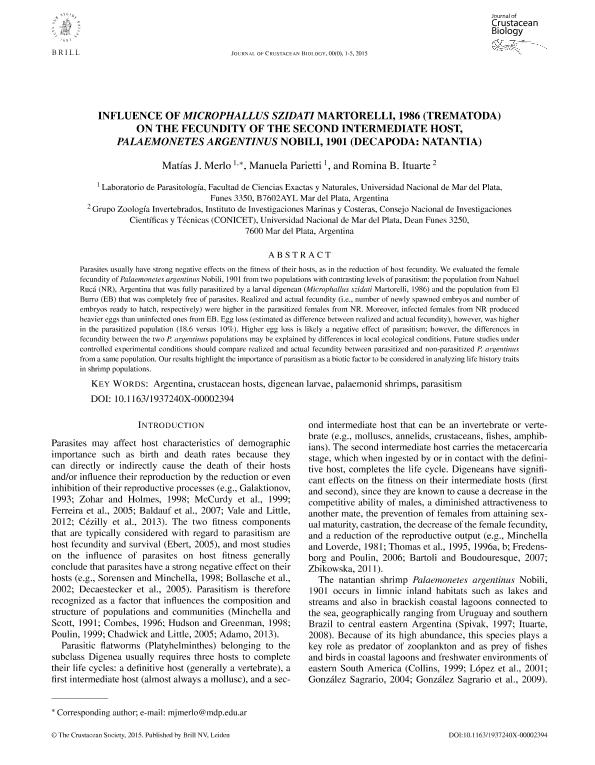Mostrar el registro sencillo del ítem
dc.contributor.author
Merlo, Matias Javier

dc.contributor.author
Parietti, Manuela

dc.contributor.author
Ituarte, Romina Belen

dc.date.available
2018-10-12T14:01:21Z
dc.date.issued
2016-01
dc.identifier.citation
Merlo, Matias Javier; Parietti, Manuela; Ituarte, Romina Belen; Influence of Microphallus szidati Martorelli, 1986 (Trematoda) on the fecundity of the second intermediate host, Palaemonetes argentinus Nobili, 1901 (Decapoda: Natantia); Crustacean Society; Journal of Crustacean Biology; 36; 1; 1-2016; 94-98
dc.identifier.issn
0278-0372
dc.identifier.uri
http://hdl.handle.net/11336/62291
dc.description.abstract
Parasites usually have strong negative effects on the fitness of their hosts, as in the reduction of host fecundity. We evaluated the female fecundity of Palaemonetes argentinus Nobili, 1901 from two populations with contrasting levels of parasitism: the population from Nahuel Rucá (NR), Argentina that was fully parasitized by a larval digenean (Microphallus szidati Martorelli, 1986) and the population from El Burro (EB) that was completely free of parasites. Realized and actual fecundity (i.e., number of newly spawned embryos and number of embryos ready to hatch, respectively) were higher in the parasitized females from NR. Moreover, infected females from NR produced heavier eggs than uninfected ones from EB. Egg loss (estimated as difference between realized and actual fecundity), however, was higher in the parasitized population (18.6 versus 10%). Higher egg loss is likely a negative effect of parasitism; however, the differences in fecundity between the two P. argentinus populations may be explained by differences in local ecological conditions. Future studies under controlled experimental conditions should compare realized and actual fecundity between parasitized and non-parasitized P. argentinus from a same population. Our results highlight the importance of parasitism as a biotic factor to be considered in analyzing life history traits in shrimp populations.
dc.format
application/pdf
dc.language.iso
eng
dc.publisher
Crustacean Society

dc.rights
info:eu-repo/semantics/openAccess
dc.rights.uri
https://creativecommons.org/licenses/by-nc-sa/2.5/ar/
dc.subject
Argentina
dc.subject
Crustacean Hosts
dc.subject
Digenean Larvae
dc.subject
Palaemonid Shrimps
dc.subject
Parasitism
dc.subject.classification
Otras Ciencias Biológicas

dc.subject.classification
Ciencias Biológicas

dc.subject.classification
CIENCIAS NATURALES Y EXACTAS

dc.title
Influence of Microphallus szidati Martorelli, 1986 (Trematoda) on the fecundity of the second intermediate host, Palaemonetes argentinus Nobili, 1901 (Decapoda: Natantia)
dc.type
info:eu-repo/semantics/article
dc.type
info:ar-repo/semantics/artículo
dc.type
info:eu-repo/semantics/publishedVersion
dc.date.updated
2018-10-09T19:56:50Z
dc.journal.volume
36
dc.journal.number
1
dc.journal.pagination
94-98
dc.journal.pais
Estados Unidos

dc.journal.ciudad
Lawrence
dc.description.fil
Fil: Merlo, Matias Javier. Consejo Nacional de Investigaciones Científicas y Técnicas; Argentina. Universidad Nacional de Mar del Plata. Facultad de Ciencias Exactas y Naturales. Departamento de Biología. Laboratorio de Parasitología; Argentina
dc.description.fil
Fil: Parietti, Manuela. Consejo Nacional de Investigaciones Científicas y Técnicas; Argentina. Universidad Nacional de Mar del Plata. Facultad de Ciencias Exactas y Naturales. Departamento de Biología. Laboratorio de Parasitología; Argentina
dc.description.fil
Fil: Ituarte, Romina Belen. Consejo Nacional de Investigaciones Científicas y Técnicas. Centro Científico Tecnológico Conicet - Mar del Plata. Instituto de Investigaciones Marinas y Costeras. Universidad Nacional de Mar del Plata. Facultad de Ciencia Exactas y Naturales. Instituto de Investigaciones Marinas y Costeras; Argentina
dc.journal.title
Journal of Crustacean Biology

dc.relation.alternativeid
info:eu-repo/semantics/altIdentifier/doi/https://dx.doi.org/10.1163/1937240X-00002394
dc.relation.alternativeid
info:eu-repo/semantics/altIdentifier/url/https://academic.oup.com/jcb/article/36/1/94/2194948
Archivos asociados
